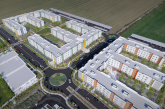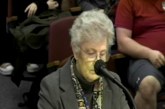
The Davis City Council is expected to adopt the budget this week and, unlike in past years perhaps, the budget itself is a relatively pro-forma exercise expected to take all of 15 minutes according to the always optimistic council agenda timeline.
But, thanks to the work of the Finance and Budget Commission, the Project Toto Team, and consultant Bob Leland, we know that the heavy lifting is not the line items of the budget itself but rather the massive unfunded components – pensions, OPEB, roads, parks, and other city infrastructure.
Unlike the official line items of the budget which will show the usual balance of expenditures and revenues, the city’s 20-year budget picture shows a $7.8 million annual shortfall over a 20-year period. And that too is probably on the optimistic side.
The Finance and Budget Commission concludes, “While the budget projections of improved property and sales tax revenues in 2017-18 are supported by local, regional and statewide data and are generally consistent with projections by other agencies, the combination of those projected revenues and the projected expenditures in the budget forecast are not sustainable either in the immediate future or in the long-term.”
As Dan Carson, Vice Chair of the Finance and Budget Commission, explained to me, the first part of that sentence simply reflects the analysis that shows “that the sales and property tax growth rates assumed in the budget plan for the immediate budget year are in line with county and state tax collection data particular to the City of Davis and with projections of short-term growth in these revenue sources prepared by the Legislative Analyst, the Department of Finance, and the state Board of Equalization.”
In other words, nothing to see here.
The second part is more interesting. As noted, “We face an average annual gap of $7.8 million over the next 20 years for the resources needed to sustain our programs and infrastructure.”
That of course assumes that the sales tax measure passed in 2014 is renewed in 2020. That seems like a reasonably safe assumption, even though many will cry foul that the tax was supposed to be temporary. I get it, but it’s not like the city went out and splurged in the last three years.
The failure to pass a renewal on the sales tax would mean, according to Dan Carson, the funding gap would more than double – to nearly $17 million a year.
Dan Carson tells me, “All of this is why the commission continues to make the case for moving forward with a comprehensive strategy for cost containment and revenues, including steps like economic development and leveraging surplus city assets, to narrow that gap.”
The key is comprehensive strategy. Earlier this year, I argued that the biggest thing that the council needs to do is cost containment. In February 2016, Robb Davis put forward a seven-point plan for cost containment.
We are going to need both economic development and taxes, but without a firm commitment to cost containment any revenue measure and any economic development revenue increase will be eaten away by cost increases for employee compensation.
But, even if we hold the line of new spending, we face challenges. In December 2016, Mayor Robb Davis told the Vanguard: “The most updated analysis by the City-contracted actuary indicates that even if employee salaries do not grow at all over the next five years, our required pension contributions across all employee groups (police, fire and miscellaneous) will grow by over $4.8 million per year compared to today.”
He added that “while it is true that we are ‘keeping up’ as things stand currently, the cost of ‘keeping up’ continues to grow and that crowds out funding for other projects our community needs to maintain the level of service citizens expect.
“Something must give,” he said. “Thus, I am less sanguine than our City staff. In fact, it is not clear to me at this point how we are going to cover everything over the next five years, given that we are not even covering critical infrastructure backlogs now.”
Simply raising tax revenue is not enough. That revenue will easily be crowded out by increased costs to provide current levels of service and current levels of compensation.
So cost containment has to be at the forefront of any comprehensive strategy.
Second is going to be a tax measure and, again, the Vanguard has been critical of the council because they have known since at least 2014 that they needed another revenue measure besides the sales tax. They couldn’t agree on a tax in 2014 after being scared off by polling. They couldn’t agree on a tax for June 2016. And they didn’t attempt to put a tax on the ballot in November 2016.
That discussion is clearly coming in July, and they’ll need to act relatively soon if they want to aim for June 2018.
Finally, there is the need for economic development.
Davis receives less in per capita sales tax than many other comparable cities, as our work from last summer demonstrates. But it is actually worse than that – Davis heavily relies on auto sales, which is ironic for a community that purports to be green and wants to be on the technological edge. Without finding ways to shore up its revenue generation, the city will struggle to be fiscally viable.
The defeat of Nishi, some would argue, has been offset by Area 52 and the University Research Park, however, as the now quickly becoming dated Studio 30 report notes, “The current isolated and dispersed sites that are available and appropriately zoned are not adequate in terms of size, location, or configuration (and related constraints) to address the emerging market need of an Innovation Center.”
Studio 30 instead said, “A combination of one ‘close in’ hub or incubator with one (or in some future time, two) larger, less constrained (and presumably less costly) edge site offers the right mix of University proximity and identity with the expansion capability to address job growth and rapid business expansion.”
At this point, I tend to believe that Mace Ranch Innovation Center (MRIC) is the last best chance in the near-term to develop a peripheral innovation park – something that can generate perhaps $10 million or more in city revenue on an annual basis.
While I believe we need taxes to shore up the budget in the immediate future, the advantage of economic development is that it is job producing and can spawn the economy, whereas taxes would generate revenue, but without the benefit of jobs or other economic development.
As we pointed out with recent pieces, retail is increasingly problematic as a revenue generator in the long term. The city has resisted peripheral retail and that has proven to be a prudent course of action. We remain heavily reliant on auto sales which also figures to be increasingly dicey as time goes on.
The budget therefore is a quick and easy discussion. Fixing the long term fiscal health of the city is going to be more complicated and contentious, and will extend well beyond the 15-minute agenda item on this week’s calendar.
—David M. Greenwald reporting







Money? Who cares about that? The CC courageously took on plastic straws and lived to tell the tale.
LOL, one step at a time. Onward to plastic forks.
I don’t disagree with anything David wrote or the Mayor’s consistent and warranted focus on the city budget. However, I wish to offer some food for thought on Nishi. If Measure A had been approved last November, it could in all likelihood have turned out that the City of Davis would have received very little property tax revenue. Based on the past predatory practices of UC Davis, in all likelihood two things would have happened:
(1) UCD could have executed master leases on some or all of the apartments. This seems to be UCD’s pattern of practice; instead of building the on-campus apartments to which it was committed in the Board of Regents 2002 student housing report, UCD instead takes the easy route and simply takes control of existing off-campus apartment buildings. If that would have occurred after completion of the Nishi apartment dwellings, the owner would have then filed for a property tax exemption based on UCD’s tax exempt status.
(2) UCD could have purchased or leased much of the commercial space, similar to the space into which it recently proposed to expand for the semiconductor materials growth lab. Whether purchased or leased by UCD, the Nishi commercial properties would have been removed from the Yolo County property tax rolls.
Why do I label UCD as “predatory.” Simply because the university has a long history of real estate transactions that completely disregard the fiscal health and welfare of City of Davis and Yolo County. For example, the 1989 MOU executed between the City and UCD stated that the City was already losing about $80,000 in tax revenue annually because of UCD’s acquisition of off-campus commercial property. The MOU stipulated that within 2 years the City and UCD would agree upon a mechanism for mitigating the fiscal impact on the City. I have yet to find any evidence that such an agreement was ever executed. As a more recent example, earlier this year UCD offered over $160 million to purchase the University Research Park. Fortunately, it was purchased by Sacramento developer Mark Friedman for $170 million. Had UCD’s bid been successful, the university would have immediately filed for a property tax exemption.
I supported last year’s proposal for the Mace Ranch Innovation Center, but had reservations about placing housing at that location. Although the site is far from campus, it would not have surprised me if UCD would have attempted to master lease rental housing at MRIC, further depriving the City and County of badly needed property tax revenue.
Greg,
Because of the possibility that the campus or nonprofits might occupy either commercial or apartment space within Nishi, the Finance and Budget Commission sought inclusion of provisions to offset the risks you cite in the development agreement for the project. That advice was accepted and the final agreement included a requirement that the development contribute to the city an annual assessment that exceeded the total amount of property tax revenue projected to come from the entire project.
The project would also have generated sales tax and a variety of other revenue and fees for the city. That led our commission to conclude that the project would have been a significant positive fiscal outcome for the city.
I was prepared to seek similar protections for MRIC but negotiations on a development agreement never got very far before the project application was suspended.
That said I completely agree that the campus has fiscally harmed the city in the past by master leases of apartments and occupancy of scarce commercial space within the city limits. The commission called attention to this concern when it advised the City Council last year to seek a binding and enforceable agreement with the campus as mitigation for the potential negative effects of the Long Ramge Development Plan on the city as other cities have succeeded in doing with their campuses.
One last point: Interland sold for $70 million, not $170 million, according to published reports at the time. But yes, I agree, the city would have been harmed had the campus purchased it.